When it comes to brushing a Poodle, there is an ongoing debate about whether it is better to brush their coat while it’s wet or dry. Both methods offer unique advantages, and choosing between them largely depends on your grooming goals, your Poodle’s coat condition, and the specific tools you have at hand. So, Is it better to brush a poodle wet or dry?
Below is a comprehensive comparison of wet vs. dry brushing, including when to use each and how to get the best results. Using the ideal brushing tool for Poodle fur maintenance ensures their coat remains tangle-free and shiny.
Quick Navigation
Know About The Poodle’s Unique Coat
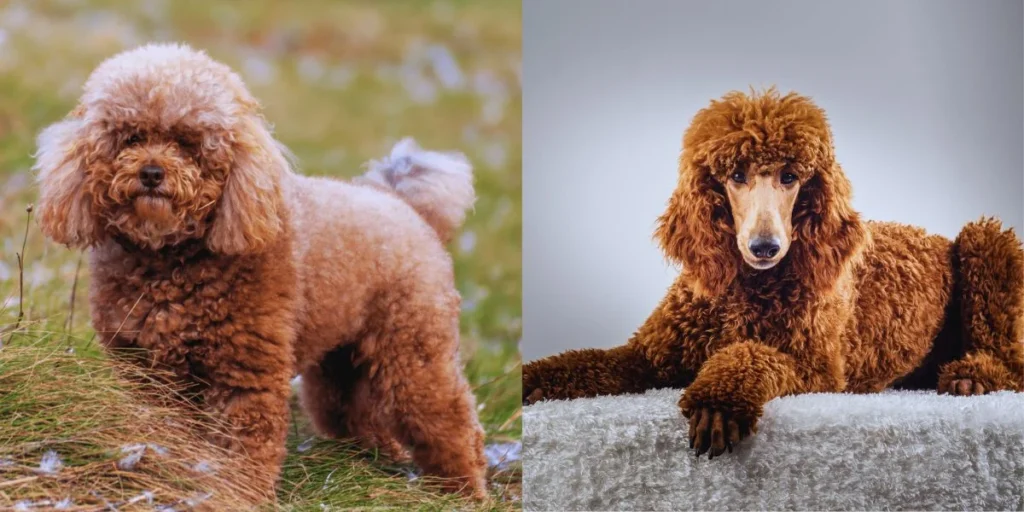

Poodles are known for their distinctive curly or corded coat, which is prone to tangling and matting if not properly groomed. Regular brushing is essential to maintain their coat’s health, prevent mats, and promote the even distribution of natural oils. Poodles typically have low-shedding coats, but they still require consistent grooming to keep their fur healthy and neat.
When to Consider Wet Brushing For Poodle?
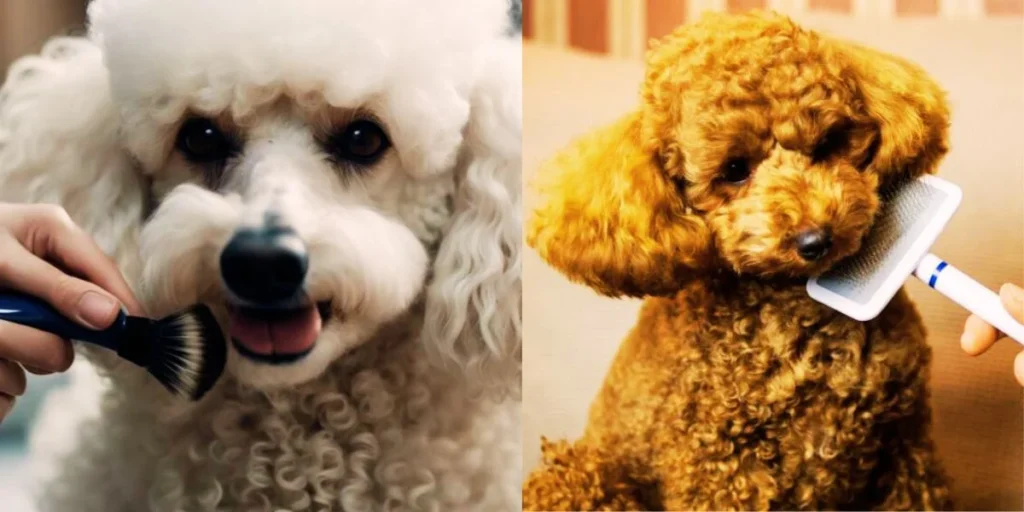

Wet brushing refers to grooming your Poodle’s coat while it is damp, usually after a bath or by misting the fur with water or a conditioning spray. This method has specific benefits:
Pros of Wet Brushing
- Reduced Breakage: Brushing a wet coat minimizes the risk of hair breakage since the moisture makes the hair more elastic. Wet brushing is especially beneficial for Poodles, whose curly hair can easily snap if brushed dry and brittle.
- Easier Detangling: Wet hair is softer and easier to work through when tangled. Using a slicker brush or wide-toothed comb while the hair is wet allows you to gently remove knots and mats, preventing the discomfort that can arise from brushing tangled dry hair.
- Deeper Conditioning: Brushing the coat when wet helps distribute conditioning products more effectively, allowing them to penetrate the hair better. This leads to a smoother, shinier coat once dry.
Cons of Wet Brushing
- Risk of Mildew: If the coat isn’t dried thoroughly after wet brushing, it can develop mildew or other skin issues. It’s essential to dry your Poodle properly with a blow dryer on a low heat setting to prevent moisture from lingering in the curls.
- Time-Consuming: Wet brushing often takes longer because it’s usually done in conjunction with bathing and drying. For owners looking for a quick touch-up, this method might be too involved.
When to Consider Dry Brushing For Poodle?
Dry brushing is often used for quick, routine grooming when the coat is not freshly washed. It offers a different set of advantages:
Pros of Dry Brushing
- Convenience: Dry brushing is more efficient for day-to-day maintenance. It’s easier and faster to brush a dry coat than to go through the process of wetting, conditioning, and drying.
- Natural Oil Distribution: Brushing a dry coat helps distribute the natural oils from the skin throughout the fur. This keeps the coat shiny and healthy by moisturizing the hair shafts and preventing dryness.
- Less Fragile Hair: Dry hair is sturdier, which makes it easier to work with, especially for daily touch-ups. Regular dry brushing helps manage the overall texture and appearance of the coat without needing a full grooming session.
Cons of Dry Brushing
- Risk of Breakage: Brushing dry hair can sometimes lead to breakage, particularly if the coat is tangled. Poodles’ curly hair is delicate, and dry brushing without detangling sprays or conditioner can cause split ends and hair damage.
- Static and Frizz: Dry brushing can create static, which makes it harder to brush through the coat smoothly. It can also result in a frizzy appearance, which is undesirable for the neat, elegant look Poodles are known for. Learn the step-by-step guide on how to brush your Goldendoodle effectively, making grooming a breeze.
7 Steps for Dry Brushing a Poodle
- Gather Tools: Use a slicker brush, a metal comb, and, optionally, a de-matting tool for small mats.
- Prepare Your Poodle: Ensure your dog is calm and positioned on a non-slip surface, like a grooming mat.
- Start with the Legs and Feet: Gently brush from top to bottom, focusing on areas that tend to mat, like between the toes.
- Brush the Body: Use the slicker brush in sections, brushing with the fur’s direction, and gently lift the fur to reach the undercoat.
- Brush the Ears and Neck: Carefully brush around the ears and neck, where matting can occur, using softer strokes.
- Finish with the Tail and Belly: Brush the tail and the sensitive underbelly, being gentle in these areas.
- Comb for Final Check: Use the metal comb to ensure there are no leftover tangles, especially in tricky areas like behind the ears.
7 Steps for Wet Brushing a Poodle
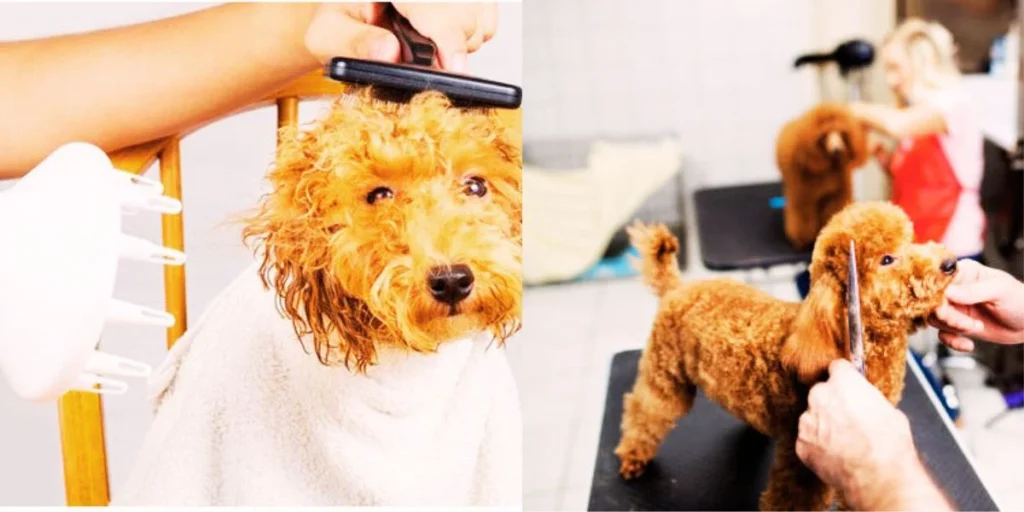

- Gather Tools: Use a slicker brush, comb, conditioner, and towel.
- Bathe Your Poodle: Shampoo your dog and rinse thoroughly, then apply a detangling conditioner to soften the coat.
- Towel Dry: Gently pat the coat with a towel to remove excess water. The coat should be damp, not soaking wet, for brushing.
- Brush While Damp: Start brushing with the slicker brush, working through the coat in sections to detangle while the conditioner is still in.
- Focus on Problem Areas: Pay extra attention to areas prone to matting, like the ears, neck, and underarms. Use gentle, short strokes.
- Rinse and Dry: Rinse out the conditioner, then towel dry again, or use a low-heat blow dryer to ensure the coat is fully dry.
- Comb for Final Smoothness: Once dry, go over the coat with a comb to check for any tangles, and ensure the coat is smooth and mat-free.
By following these simple steps for both dry and wet brushing, you can maintain your Poodle’s coat in excellent condition, ensuring it stays mat-free, clean, and healthy.
Comparison Dry Brushing Vs Wet Brushing For Poodle
So, Is it better to brush a poodle wet or dry? Here’s the comparison between Poodle Dry Brushing and Wet Brushing:
Combining Both Methods for Optimal Results
To keep a Poodle’s coat in top condition, most professional groomers recommend using both wet and dry brushing methods strategically. Regular dry brushing can help maintain the coat between baths, keeping it free of loose hair and dirt. On the other hand, wet brushing should be reserved for deeper grooming sessions, particularly after baths, when you need to detangle and hydrate the coat. For more advice, refer to the essential care guide for your Cane Corso puppy to raise a happy and healthy dog.
How Often Should You Brush Your Poodle?
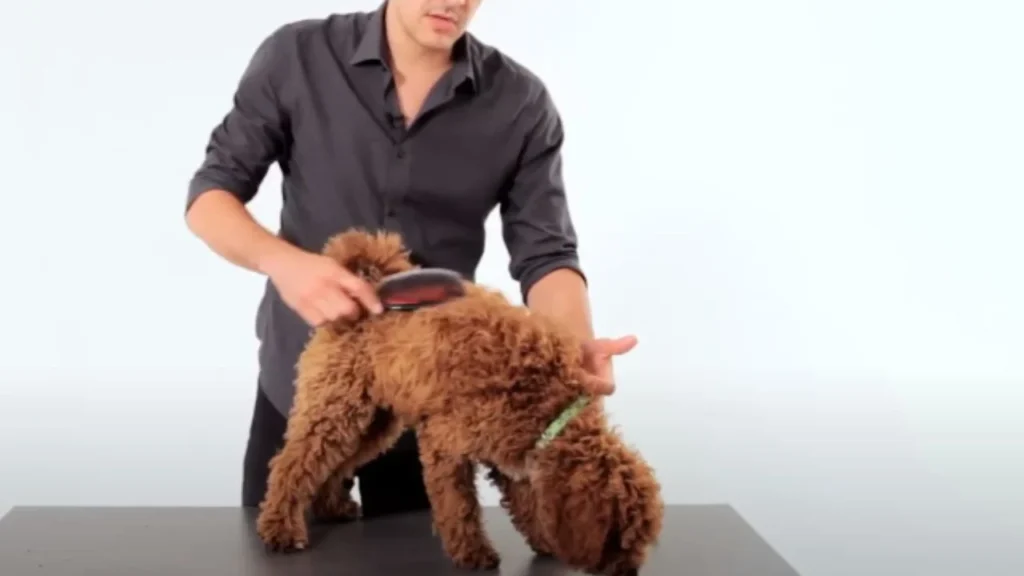

You should brush your Poodle daily or every other day if they have a curly coat, as this helps prevent matting and keeps their coat healthy. Straight-coated Poodles can be brushed 2-3 times a week. Regular brushing is crucial to avoid tangles and maintain coat health.
How often you should brush your Poodle depends on their coat type, activity level, and lifestyle. To maintain a well-groomed and healthy coat, you can also find out how often you should brush your Australian Shepherd.
Here’s a breakdown based on these factors:
1. Coat Type
- Curly-Coated Poodles: The most common type, these poodles require brushing every day or at least every other day. Their dense, curly fur is prone to matting and tangling if not maintained regularly.
- Corded-Coated Poodles: These poodles, with their distinct rope-like cords, need much less frequent brushing. You can brush them only a few times a year, as excessive brushing could damage their cords.
- Straight-Coated Poodles: These Poodles require brushing two to three times a week. Although less prone to matting than curly coats, regular maintenance is essential to avoid tangles and dirt buildup.
2. Activity Level
- High-Activity Poodles: If your Poodle spends a lot of time outdoors or engages in activities like running, swimming, or hiking, brushing is necessary daily. This helps remove dirt, debris, and potential tangles from the coat.
- Low-Activity or Indoor Poodles: For Poodles who lead a more sedentary lifestyle or spend most of their time indoors, brushing three times a week is usually sufficient. This frequency helps maintain a smooth, clean coat without needing to remove much outdoor debris.
3. Lifestyle Considerations
- Show Poodles: Dogs that compete in shows need daily grooming to maintain their coat’s show-quality appearance. This includes regular trims, brushing, and even professional grooming.
- Pet Poodles: For a family pet that isn’t competing, a regular routine of brushing two to three times a week works well, ensuring the coat stays mat-free and healthy. However, in periods of heavy outdoor play or shedding, daily brushing may be necessary.
- Poodles in Humid or Wet Climates: In more humid environments, matting can occur more frequently due to moisture, requiring more frequent brushing to avoid tangles, perhaps even daily.
Why Regular Brushing is Essential?
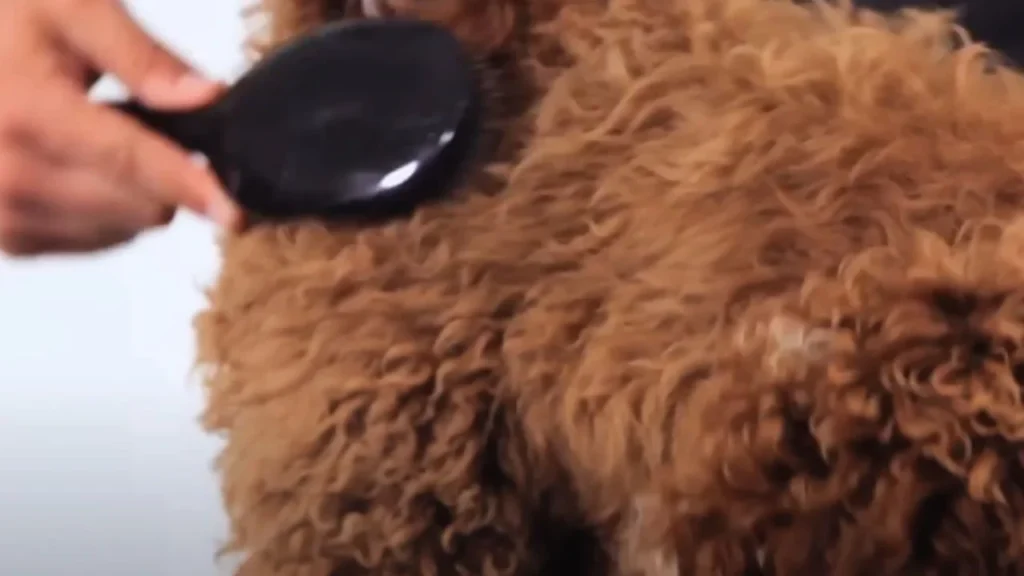

How often you should brush your Poodle depends on their coat type and lifestyle. Curly-coated Poodles should be brushed daily or every other day to prevent tangles and matting, while straight-coated Poodles require brushing 2-3 times a week. Corded-coated Poodles, on the other hand, need much less frequent brushing around every few months.
Regular brushing not only helps keep the coat clean and free from dirt but also promotes healthy skin by distributing natural oils. If your Poodle is very active outdoors, you may need to brush more frequently to remove debris from their coat. For additional help with cleaning up around the house, check out these tips for getting dog hair off your blanket, keeping your home clean and hair-free.
Wrapping Up: Is it Better to Brush a Poodle Wet or Dry?
In conclusion, whether it’s better to brush a Poodle wet or dry depends on the specific grooming goal and the condition of the coat. Dry brushing is ideal for regular maintenance, as it helps remove loose hair and minor tangles and keeps the coat fluffy. This method is best for daily or routine grooming sessions. Hope so, now you know the answer to: Is it better to brush a poodle wet or dry?
On the other hand, wet brushing is more effective after a bath, especially with detangling conditioner, as it helps manage serious mats and tangles by making the coat more pliable. Both methods serve their purpose, but a combination of dry brushing for daily care and wet brushing after bathing ensures a healthy, well-maintained coat. For more detailed insights, check out the best grooming routine for a Goldendoodle’s fur to prevent matting and tangles.




